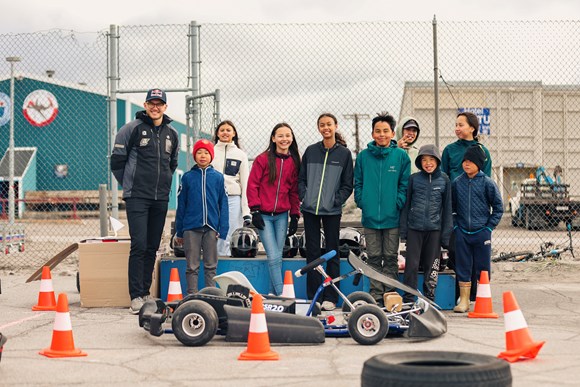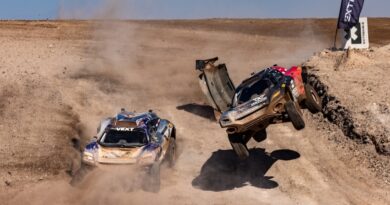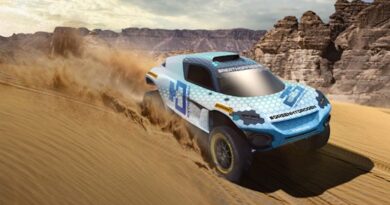Extreme E visits legacy programme at base of world’s second largest ice sheet in Greenland
Extreme E’s inaugural season featured the first international sport to take place in the Arctic Circle, as 18 world-class drivers travelled to Greenland to race at the base of the world’s second largest ice sheet.
This year, Kevin Hansen and Hedda Hosås joined the championship as it went back to the world’s largest island to revisit the race site and check in on the series’ ongoing Legacy Programme.
When it comes to the climate crisis, few places have felt the impact quite like Greenland. The melting of its ice sheet presents the single greatest threat to sustainable sea levels, with many scientists predicting that a complete melting of the one-million-year-old ice cap could lead to a seven-metre sea level rise over the next 350 years.
In step with this stark reality, Extreme E endeavoured to radically minimise the environmental impact of the Arctic X Prix in August 2021. As documented by world-renowned EY’s Social and Environmental Impact Design Considerations Report, most impact factors, such as contamination, protected areas and noise, were judged to be low risk, with none deemed a high risk to Greenland and its environment.
Kevin Hansen, JBXE, said: “I remember the first time I was in Greenland, I was really shocked, so I can just imagine how it was for Hedda [Hosås] to go for the first time. It’s something that brings back a lot of emotions I think, because it really affected me last time I was in Greenland.
“It’s an absolutely beautiful location. To do a race in the region, raise awareness for climate change and the melting ice sheets, and then to come back and see that it’s like we were never even there, is amazing.
“I think that’s hugely important to remember, that we don’t come to these places to make a mess and just do it for good action. We come to these locations to make a difference.”
Laust Logstrup, Kangerlussaq Town Mayor, said: “Where the race site was located, the sand has been blowing over the area and there are flowers where the camp was situated. You cannot see that there had been a race taking place there last year. This is certainly a race without a trace.”
At the centre of the Extreme E Championship are its Legacy Programmes. Set up in each race location, these aim to provide positive support relating to specific local needs. Last year, Extreme E set up a series of projects at the local school in the town of Kangerlussuaq as part of leaving a positive legacy.
These projects included the installation of solar panels outside of the school gates in partnership with XITE ENERGY Racing and myenergi, as well as helping implement climate into the curriculum in Greenlandic so it was accessible to all. The programme was rolled out to 3,600 young people across Greenland.
Another key aspect of the Legacy Programme were the electric go karts presented to the school in collaboration with the Danish Automobile Sports Federation.
Ali Russell, Chief Marketing Officer of Extreme E, said: “The reason that we come to places like Greenland is all about legacy. We’re using sport for good and it’s the catalyst of change.
“In Greenland, it’s about E-mobility and renewable energy, as well as the power of having a female driver. Young girls are looking up to Hedda [Hosås] and understanding that they too could be a driver in the future.
“We’re in the middle of nowhere in the Arctic Circle and we’ve got kids that have an aspiration to be sports stars and why shouldn’t they? It’s one of the parts of the job that makes me, and our team feel very, very good about being in Greenland and carrying out these Legacy Programmes.”
During their visit to Kangerlussaq, Hansen and Hosås led a workshop on climate change and also gave the students pointers as they made their way around the track in their sustainably powered go karts.
Hedda Hosås, JBXE, said: “It is great to be a part of this championship and getting this opportunity to travel to a place like Greenland was an incredible experience.
“The school visit was really fun. We met all these kids, including some girls, and that really felt like I was their role model. I could really feel it was good.
“At the same time, it was really sad when Kevin told me and showed me some pictures from last year. Seeing the difference, how the ice has melted so fast, it’s sad to see, but also a great experience and a memory for life.”
An exciting surprise came from student Magnus Asmussan who, off the back of the race last year, had built his very own Extreme E car.
Magnus Asmussan, Qinnguata School student, said: “We kind of dreamed about it since last year. We saw the big race and we just were amazed. So, we tried building a car to race in and we put X44 on the car because we loved how Seb [Loeb] was driving – he was just aggressive. It was exciting and cool!”
Extreme E looks forward to returning to Greenland to help progress its Legacy Programme further in the near future.






